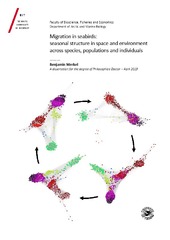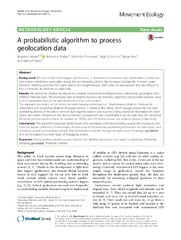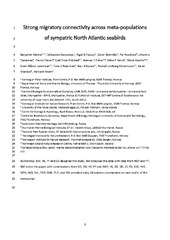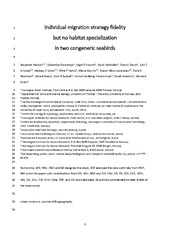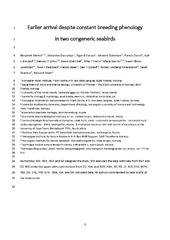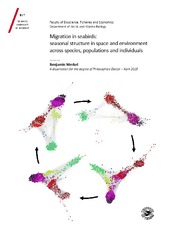| dc.contributor.advisor | Yoccoz, Nigel Gilles | |
| dc.contributor.author | Merkel, Benjamin | |
| dc.date.accessioned | 2019-04-30T11:47:07Z | |
| dc.date.available | 2019-04-30T11:47:07Z | |
| dc.date.issued | 2019-05-21 | |
| dc.description.abstract | Identifying drivers of population trends in migratory species is difficult, as they can face many stressors while moving through different areas and environments during the annual cycle. Their population response to environmental change may in addition be affected by consistent differences in individual behaviour, which are widespread in free-living populations. An understanding of the structure of migration in space and time across species, populations and individuals is necessary to identify potential plasticity and constraints for migratory species in a rapidly transforming physical and biological environment. This thesis uses two congeneric long-distance migrants of the genus <i>Uria</i>, the common (<i>Uria aalge</i>) and Brünnich’s guillemot (<i>Uria lomvia</i>) to address these questions. To this end, I utilized a large light-level geolocator tracking dataset of 887 individual guillemots breeding at 16 colonies across the Northeast Atlantic, tracked over 10 years resulting in 1740 annual tracks.
Through the development of a novel method to estimate locations from twilight timings, I was able to correct biased estimates for part of my dataset, which made the overall dataset comparable. Further, with the inclusion of information about the species’ biology as well as several spatial masks, the method was able to estimate locations also during times of equinox. This in turn made it possible to investigate migratory connectivity (i.e. the connection between breeding and no-breeding regions) and individual migration strategy fidelity (i.e. consistency of individual migratory behaviour) throughout the non-breeding period.
Both guillemot species are comprised of space use specialists selecting for specific sites rather than habitats. They breed in colonies displaying strong migratory connectivity, within and between species. This was apparent through a combination of colony-specific seasonal space use and occupied environmental niches, grouping Northeast Atlantic Brünnich’s guillemot populations into two and common guillemot populations into five previously undescribed spatiotemporal movement clusters. Remarkably, common guillemot populations clustered in accordance with the variable population trends exhibited by the species, while Brünnich’s guillemot populations are all declining where their trends are known. Colony-specificity was also visible in the exhibited temporal variations of individual migratory movements due to the species breeding biology. Birds were flightless during their autumn moult constricting their movement. Likewise, individuals were constricted to quasi central place foraging during spring prior to egg-laying after arrival back at their colony. These two periods were visible as constricted space and environmental use and often lack of individual specific behaviour. Arrival dates back at the colony were highly variable between species and colonies and could be best explained by colony size. Unlike timing of egg-laying, arrival date advanced considerably in recent years across the study area in both species, demonstrating that different events in seabird phenology can show different temporal trends.
Migratory behaviour is likely shaped by a combination of the physical properties of the occupied environment, energetic constraints faced due to the animal’s physiology and foraging adaptations, inter- and intra-specific competition for food resources as well as nest sites, and conservative migratory behaviour. These traits might leave migrants vulnerable to large-scale perturbations of their environments, which occur at an ever increasing rate, while the compartmentalised annual distribution allows for the potential extinction of an entire population by regional threats, anthropogenic or otherwise. | en_US |
| dc.description.doctoraltype | ph.d. | en_US |
| dc.description.popularabstract | Animal migration is a widespread phenomenon in nature. But, many migrants are dwindling in numbers. This is especially true for seabirds, the most threatened group of all birds, which spend most of their life on the open ocean. The aim of this thesis was to understand how migration is structured in two species of seabirds, the common and Brünnich’s guillemot, which breed across the Northeast Atlantic. To this end, I developed a novel method to estimate a bird’s locations when at sea using small data loggers that record light and time. Both species spread out over large parts of the North Atlantic during the non-breeding period. However, breeding populations showed compartmentalized space use, meaning that different populations occupied only small subregions of the total area used by all populations, rather than spreading out and mixing with other populations. Similarly, individual birds showed conservative behaviour as they used similar migration routes year after year irrespective of the habitat they encountered. Differences between populations were also visible in their migration timing. Notably, arrival timing back at the colony after the winter was highly variable between populations, but all populations from both species arrived earlier each year over the 10 study years. Their conservative migratory behaviour might leave these two species vulnerable to large-scale changes in their environment, which are occurring at an ever increasing rate, while the compartmentalised annual distribution allows for the potential extinction of an entire population by regional threats, either man made or otherwise. | en_US |
| dc.description.sponsorship | Funding for this thesis and most data collection was provided by the Norwegian Ministry for Climate and the Environment, the Norwegian Ministry of Foreign Affairs and the Norwegian Oil and Gas Association through the SEATRACK project (www.seapop.no/en/seatrack) In addition, some data collection has been funded by the Research Council of Norway (project 216547), TOTAL E&P Norway and the TOTAL Foundation and the UK Natural Environment Research Council’s National Capability. | en_US |
| dc.identifier.isbn | 978-82-8266-169-0 | |
| dc.identifier.uri | https://hdl.handle.net/10037/15239 | |
| dc.language.iso | eng | en_US |
| dc.publisher | UiT The Arctic University of Norway | en_US |
| dc.publisher | UiT Norges arktiske universitet | en_US |
| dc.relation.haspart | <p>Paper I: Merkel, B., Phillips, R.A., Descamps, S., Yoccoz, N.G., Moe, B. & Strøm, H. (2016). A probabilistic algorithm to process geolocation data. <i>Movement Ecology, 4</i>, 26. Also available at <a href= https://hdl.handle.net/10037/10133> https://hdl.handle.net/10037/10133</a>.
<p>Paper II: Merkel, B., Descamps, S., Yoccoz, N.G., Grémillet, D., Fauchald, P., Danielsen, J., … Strøm, H. Strong migratory connectivity across meta-populations of sympatric North Atlantic seabirds. (Manuscript).
<p>Paper III: Merkel, B., Descamps, S., Yoccoz, N.G., Grémillet, D., Daunt, F., Erikstad, K.E., … Strøm, H. Individual migration site fidelity but no habitat specialization in two congeneric seabirds. (Submitted manuscript). Now published in <i>Journal of Biogeography, 2020</i>, available in Munin at <a href=https://hdl.handle.net/10037/19750>https://hdl.handle.net/10037/19750</a>.
<p>Paper IV: Merkel, B., Descamps, S., Yoccoz, N.G., Danielsen, J., Daunt, F., Erikstad, K.E., … Strøm, H. Earlier arrival despite constant breeding phenology in two congeneric seabirds. (Manuscript). Published version in <i>Biology Letters, 15</i>0(10), available at <a href=https://doi.org/10.1098/rsbl.2019.0634>https://doi.org/10.1098/rsbl.2019.0634</a>. Accepted manuscript version available in Munin at <a href=https://hdl.handle.net/10037/16586>https://hdl.handle.net/10037/16586</a>. | en_US |
| dc.relation.projectID | info:eu-repo/grantAgreement/RCN/HAVKYST/208491/Norway/Drift of fish larvae, fish-stock intereactions and their effects on seabird dynamics// | en_US |
| dc.rights.accessRights | openAccess | en_US |
| dc.rights.holder | Copyright 2019 The Author(s) | |
| dc.subject.courseID | DOKTOR-002 | |
| dc.subject | VDP::Mathematics and natural science: 400::Zoology and botany: 480::Ecology: 488 | en_US |
| dc.subject | VDP::Matematikk og Naturvitenskap: 400::Zoologiske og botaniske fag: 480::Økologi: 488 | en_US |
| dc.subject | VDP::Mathematics and natural science: 400::Zoology and botany: 480::Marine biology: 497 | en_US |
| dc.subject | VDP::Matematikk og Naturvitenskap: 400::Zoologiske og botaniske fag: 480::Marinbiologi: 497 | en_US |
| dc.subject | VDP::Mathematics and natural science: 400::Zoology and botany: 480::Zoogeography: 486 | en_US |
| dc.subject | VDP::Matematikk og Naturvitenskap: 400::Zoologiske og botaniske fag: 480::Zoogeografi: 486 | en_US |
| dc.title | Migration in seabirds: seasonal structure in space and environment across species, populations and individuals | en_US |
| dc.type | Doctoral thesis | en_US |
| dc.type | Doktorgradsavhandling | en_US |


 English
English norsk
norsk